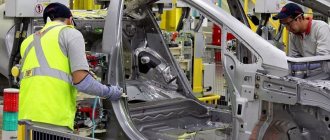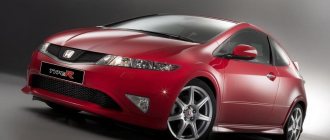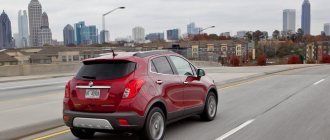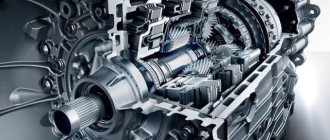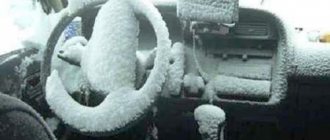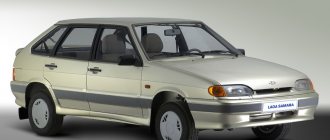This is incredible!
In the end, the search predictably drags on for months or ends with the purchase of a bucket with twisted mileage and tired equipment. But with original paint! And a month later, a gaping cyclist rams the virgin paintwork of the much-awaited swallow. It was not possible to drive an unpainted one.
And this is fine when we are looking, for example, for a family Skoda Octavia of a recent year of manufacture, but when we need a ten-year-old youth car, for example, a Honda Civic or Mazda 3, then the theory “not broken, not painted” simply becomes a utopia.
Infiniti M. Painted 4 elements, two of which are “under the instrument”
Sellers who twist their fingers at your temple after you refused to buy just because the thickness gauge on one of the wings showed an excess of the norm, in this case they are doing it absolutely rightly and that's why.
In order for you to understand how unnecessary this activity is, I will give an example of some statistics from my work as an auto picker. 80% of used cars on the market are junk cars that do not deserve attention. The majority (i.e. more than 50%) of cars older than five years have traces of secondary paint. Can you imagine now what percentage of ten-year-old cars have? But that’s not all, let’s move on. About 10% of new cars leave the car dealership with elements painted a second time, either at the factory when a defect is eliminated or at the car dealership after careless pirouettes of a driver or manager.
So, when buying an aged used car, to find a more or less intact copy with a completely original color at a normal price is incredible luck, and to refuse a good car with two or three parts cosmetically painted is stupidity, and that’s all. But, as always happens, not all yoghurts are equally healthy, which means we’ll try to figure out whether it’s worth buying a used car, or rather, what can be taken from a painted car and what should not be taken.
Damaged cars, to take or not to take?
Details Category: Blog about selling a car Created: September 04, 2018
Is it worth buying junk cars?
Most drivers who do not have sufficient driving experience buy cars that are not new. They reason: “It won’t be a shame if I break it.” But everyone wants to buy it at a cheap price, and so that it will not be in an accident! A certain neighbor made it clear to them that it was not worth taking a damaged vehicle, even with minor damage. Therefore, many beginners, and not only others, are tormented by the question: “What is scary about cars that have been in an accident?” and “Does it make sense to pay for them at all?” I propose to look into this; the task is still ambiguous.
Damaged cars
First, let’s find out what the phrase “damaged car” means. This is a car that has been in an accident in which some part of it was damaged. And here it does not matter with what force the blow was struck, whether it was applied to the body of the car or whether the wing was simply hit. Was there an accident? - WAS! Therefore, the transport is broken! By the way, resellers skillfully take advantage of this.
Damage level
This, of course, is great if you come across a car with a completely original color, but if suddenly the car that you came to check suddenly turns out to be partially with secondary paintwork, you need to find out how serious the damage was, or rather how far the foreign object traveled, causing for which we had to hire painters. So broken? Please note that for this you will have to work not only with the device, but also with your eyes.
Measuring the paintwork of the doorway
It is a big misconception to think that a thickness gauge will save you from auto junk.
A good example for you would be this Solaris, whose doors have been completely changed and painted to match the appliance, along with the hinges.
Everything is prepared in such a way that the “boy with a thickness gauge” (a novice picker) can easily hand over such a car to the client. But now you know everything. We remove the plastic sill trim, and there:
Damage to the doorway
Open each door and check the doorways for deformations, bend the seals, remove the plastic trims and look at the integrity of the spot welds, no matter how much the owner dislikes it. In the end, this procedure can be done immediately before the purchase, so that the seller, when he sees the money, becomes a little softer and fluffier.
Remove the seal and check the integrity of the seams
Under the hood, the side members, “TV”, and mudguards (“cups”) are checked for signs of repair. If you don’t know what it is, it’s better not to look for a car yourself - otherwise you’ll buy a broken “bucket”. Damage to any of the listed elements is a sign of a major accident, but these are not suitable for us and it is not worth buying such a car. Let the cars have their elements painted, but not without damaging the power structure of the body and with deployed airbags. How to check airbags for deployment
Activated airbag
How not to buy a “shifter”
The roof is a separate matter. On the one hand, this is a power element of the body - it is directly responsible for rigidity and geometry. And, in a good way, traces of putty, and indeed secondary paint, mean that you need to look further, and besides, it will be more difficult to sell such a car. However, we live in Russia. There are plenty of cases when, by the will of fate or the local mentality, garbage bags, bottles, acid from parking competitors or snow fall from above, in the end - I don’t need to tell you. It happens that the roof simply lets the “saffron milk caps” along the leading edge - and this applies not only to the domestic automobile industry. This means that you will have to learn to determine whether you are a “shifter” or not a “shifter.”
As we know, a bottle or a bag does not cover the entire surface of the sheet and attacks pointwise, but if the putty is around the entire perimeter of the roof, then most likely the car ended up lying in a ditch or the piece of snow turned out to be so large that it would have been better for the car to overturn - see the racks and all elements adjacent to the roof. Have they been renovated? Tell the seller: "Good Buy." It's not worth wasting your time on a car like this.
Deformed center pillar
Just a double uniform high-quality color without traces of putty, installation and straightening, both the roof itself and the adjacent body panels, does not mean anything bad - learn to look at it holistically.
Completely original original glazing in addition to this, but not apart from the previous conditions, indicates that this car did not roll over.
If the power structure is intact, then it’s good - we don’t have any sharp signs of refusing to buy a car with a body of such a degree of damage, which means we torment the seller with our careful observation further. All body panels are measured with a thickness gauge and checked for traces of secondary paint. And the purchasing decision will now directly depend on its quantity and quality, which we will talk about next.
In private hands...
YOU CAN find a private buyer by advertising in a newspaper or on the Internet. However, this method is unreliable and fraught with unpleasant surprises. If an expensive, prestigious or simply common model is sold in disrepair, then there will be no end to those wishing to purchase it. But keep in mind: the bulk of buyers will be resellers acting through front men. The main task of these individuals is to get a car as quickly as possible, so they often hunt almost at the scene of an accident, when the owner, as a rule, is upset and is more easily persuaded to “get rid of the scrap metal.” Such advisors keep watch over potential sellers of used cars in an insurance company, an expert agency, and a technical center...
The advantage of this option is that you can quickly sell even a wrapped or burnt copy, and by proxy - without re-issuing documents. But they won’t offer you good money for the car: it’s in the interests of resellers to bring the price down as low as possible. In addition, dealing with unknown, and especially dubious, personalities is more expensive for yourself: for example, they can easily pay with counterfeit bills. In addition, cars sold this way often soon find themselves involved in criminal cases - after all, the buyers themselves do not restore them, but only resell them. Sometimes a car goes through several new owners in just a week.
It happens that resellers only require documents for the car, which, together with the cut-out body number, are used to legalize another – stolen – car. After which the former owner one day receives a summons with a summons to the investigator to testify, or, at best, a receipt for payment of transport tax.
You can also hand over your damaged car for disassembly. Sometimes they offer a tempting price. But who will guarantee that the car will actually be dismantled for parts, and will not again be used only by documents and body or engine numbers? Therefore, this option is also unattractive.
Quality of repair
Here I want to upset you a little - even the one who prepared and painted will not say 100% whether the discovered piece of putty will fall off or not during your ownership. The only thing we can appreciate is the level of service that carried out the repairs. For example, shagreen for processing with a file, a lot of dust, sweat with base and varnish, drips, dips or, God forbid, peeling paintwork, indicate that the preparation, technology and materials, to put it mildly, are far from ideal and you need to estimate how much money you give it to me to remake this mess.
Peeling of paintwork
It often happens that the technology was followed flawlessly, but the buyer of materials saved money and bought the cheapest varnish, which after a few months of use became covered with a scattering of scratches or even began to peel off in pieces.
The varnish is peeling off
Chinese parts also do not last long without “saffron caps” and it is often difficult for straighteners to restore the former gaps. There will definitely be aesthetic problems with any TongYang.
The ideal option is when the repaired panels are painted “to match the device” or almost “to match the device” and in appearance practically do not differ from the factory coating.
Exceeding the standard paintwork by one and a half to two times is a cosmetic repair. It is least of all fraught with danger. Anything more than 300 microns indicates that a layer of putty is hidden under the “base” and, accordingly, the larger it is, the greater the chance that it will fall off during a sudden change in temperature or in the wash. A paint layer of more than 1500 microns means that the risk, so to speak, is maximum.
The number of painted parts, of course, also plays a role. If one or two metal parts are found to be in low-quality repairs, then you can bargain with the seller for money for possible rework. If there are more such panels or the car is painted differently all around, then it’s better to look further for the car, otherwise possible subsequent alterations will be expensive. It's all about risks.
Poor quality threshold color
Forgive me, but repairs involving the complete replacement of a threshold, rear wing or something else that can only be mounted by welding, by definition, cannot be of high quality, since body elements after such “heat treatment” significantly lose their original strength characteristics even when the next accident will not be handled properly. Moreover, nothing remains of the corrosion resistance of such a metal. In general, there are unnecessary risks, which are already enough when buying a used car.
Corrosion due to poor quality paint
Consequences of secondary coloring
I can definitely say that a body whose power elements have been damaged will definitely be covered with a scattering of consequences, since such impacts that reach the side members and struts at least change the geometry of the most important thing - the frame. It is impossible to restore it outside the factory conditions; accordingly, the second such strike will go much further than the one that already happened. In general, it is unsafe to operate such a car. When buying a car that is so damaged, there may be problems with setting the wheel angles, which may result in constant vibrations and increased tire wear, but these are minor things.
If only the body panels of the car suffered, then there is always a risk that something could go wrong, so when buying a car, you need to include in the budget the possible rework of elements. A seemingly ideal secondary color can never be definitely considered to be of high quality. Only time will tell how responsibly they approached the work, and the consequences on painted parts may be as follows:
— fading of the “base” with the appearance of different colors;
- varnish peeling;
— peeling of putty;
— corrosion and swelling;
- increased sensitivity to scratches, abrasions, and chips.
We buy
As you can see, there are certain risks in buying a car with repainted elements, however, if there were no serious and numerous damages, then it would be naive and stupid to refuse a good example. In addition, most often, normally painted parts do not make themselves felt for several years. Even if something starts to peel and become discolored, today it’s not that expensive to repaint one or two elements, and you can put off repairs as long as you like, even until the next car sale. The same cannot be said about the technical problems of cars that were not beaten or painted, but were not properly maintained. The question is often asked: “What is better, buying a car with a painted fender or a dented one?” With a wrinkled one. The best thing is that you will have the opportunity to choose the service yourself or reserve the right to forget and drive as is, asking the seller for a discount on restoring aesthetics. One catch - sellers often don’t discount much, citing the example of fabulous workshops where supposedly for 500 rubles they do everything without painting so that “it won’t work.” Paint and don’t be afraid to buy painted ones, but don’t forget that you will need knowledge, attentiveness and, of course, at least a little experience.
Author: Denis Putkov,
Related article: Correct check of a car's paintwork - signs of secondary paint
Is it worth buying a used car?
The issue of buying a car after an accident is very controversial, as any driving instructor with an automatic transmission will confirm. Such a purchase is risky, and you need to be prepared for it.
A situation often arises when a car damaged in a traffic accident is somehow repaired to return it to its salable condition, and then put up for sale. In the event of a serious accident, the geometry of the body of such a car is deformed in almost one hundred percent of cases (meaning the power structure). Even a seemingly minor deformation of the spar can cause a problem such as periodic “pulling” of the car to the side while driving and increased wear of the tires, since the wheel alignment angles will no longer be adjustable. And if the windshield opening is skewed, then cracks will appear on it not only at the slightest chip, but also just like that, for no reason.
Even if the vehicle was restored by professionals, this does not guarantee the complete safety of such a vehicle. Many parts damaged during the accident do not need repair, but replacement, which requires a correspondingly larger amount spent, which does not always suit the owner. The mechanical characteristics of the metal, even though it is pulled out after an accident, will still be very far from the original ones. And if the car gets into an accident again, the metal will behave differently and deform randomly, and not as intended by the manufacturers. In addition, it is not known whether the airbags on such a car were replaced, since this replacement is expensive, and not always in the best interests of the owner. And welding, used in the process of body repair, leaves marks that inevitably rust, despite special protection. Also, the quality of painting will still not be performed at the manufacturer’s level - so it is possible that the car will have to be painted again.
Any driver, even an automatic driving instructor, understands what pitfalls a buyer can expect when buying a used car. However, you should not be as distrustful of a car with replaced or mounted bumpers - this may only indicate a desire to hide a dent or scratches on the car. But you definitely shouldn’t trust sellers who assure you that there are absolutely no body defects - if a used car looks good, most likely it was completely repainted before being sold.
| Tweet |

